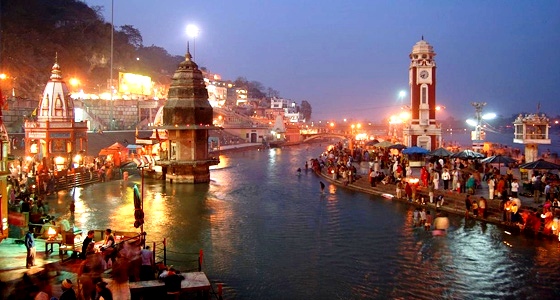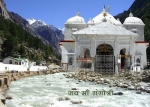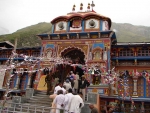In the folds of the snow-covered reaches of the lofty Garhwal Himalayas in Uttarakhand are located the sacred Hindu shrines of Badrinath, Kedarnath, Gangotri and Yamunotri. They together form the Char Dham or the Four Holy Shrines. The region is referred as the land of the gods in the ancient Puranas. Scores of pilgrims visit the shrines by trekking arduously along the mountain paths, all for a communion with the divine.
BADRINATH- Cradled in the twin mountain ranges of Nar and Narayan is the holiest of the four main shrines, Badrinath along the left bank of river Alaknanda. With the splendid Neelkanth Mountains as the backdrop, it is an important destination for every devout Hindu. The temple of Shri Badrinath on the banks of the Alaknanda river dates back to the Vedic times. Situated at an altitude of 3133 mts., the present temple is believed to have been built by Adi Guru Shankaracharya. Also known as `Vishal Badri`, Badrinath is one of the Panch Badris`
KEDARNATH- Amidst the dramatic mountains capes of the majestic Kedarnath range stands one of the twelve `Jyotirlingas` of Kedar or Lord Shiva. Lying at an altitude of 3584 mts. on the head of river Mandakini, the shrine of Kedarnath is amongst the holiest pilgrimages for the Hindus. According to legend, the Pandava sought the blessings of Lord Shiva to atone their sins after the battle of Mahabharata. Lord Shiva eluded them repeatedly and while fleeing took refuge at Kedarnath in the form of a bull. On being followed, He dived into the ground, leaving behind his hump on the surface. This conical protrusion is worshipped as the idol in the shrine. The remaining portions of Lord Shiva are worshipped at four other places - the arms (bahu) at Tungnath, mouth (mukh) at Rudranath, navel (nabhi) at Madmaheshwar and hair (jata) at Kalpeshwar. Together with Kedarnath, these places are known as the Panch Kedar.
GANGOTRI- According to mythology, Goddess Ganga - the daughter of heaven, manifested herself in the form of a river to absolve the sins of King Bhagirath`s predecessors, following his severe penance of several centuries. Along the right back of Bhagirathi stands the shrine of Gangotri dedicated to the Goddess. By November, Gangotri is covered by snow. It is believed that the Goddess retreats to Mukhba, her winter abode (12 kms downstream). The physical source of the holy river is at Gaumukh, 18 kms. Further uphill, along the Gangotri Glacier. Several pilgrims trek upto the source to offer prayers either on foot or on ponies.
YAMUNOTRI- One of the Char Dham according to Hindu mythology, Yamunotri is the origin of the sacred river Yamuna. Famous for its thermal springs and glaciers, it is one of the most important stopovers on the itinerary of the Hindu pilgrim. According to an old legend, Asit Muni, the revered sage, used to reside here. The main temple is dedicated to Goddess Yamuna. Holy dips in the nearby tank filled by hot springs and cooking rice in its water are common rituals performed by the devotees.
LOCATION- Each of the four holy shrines of the Char Dham Yatra is located at a height above 3,000 m above sea level. The four temples in a geographical context form two distinct groups that of Badrinath-Kedarnath and Gangotri-Yamunotri, with the common starting point at Rishikesh.
Badrinath-Kedarnath lie towards the northeast of Rishikesh. Gangotri and Yamunotri are up north from Rishikesh. Of these sites, Badrinath and Gangotri are directly accessible by road while Kedarnath is reached by road followed by a short trek of 15 km from the Gaurikund road head. Yamunotri is a 13-km trek from Hanuman Chatti.
BEST TIME TO VISIT- Summers (April to June), is the best time to visit, when the weather is clear in the hills with stress-reliving temperature.





